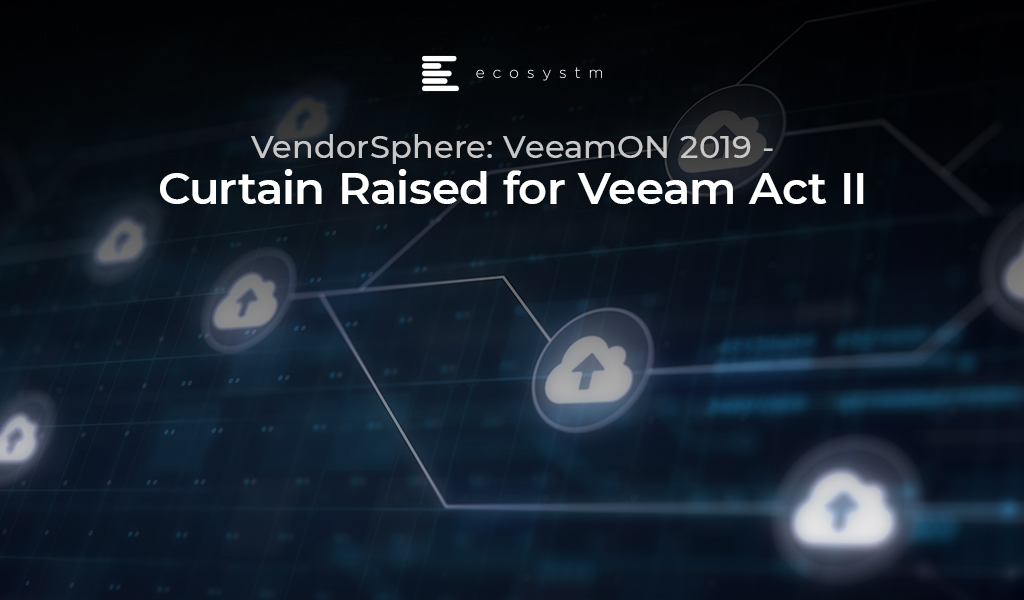The 5th VeeamON event held in Miami Beach recently, attracted around 2,000 customers and partners. The 2-day conference is the annual Veeam gathering of mainly IT admins to learn about and get certification for Veeam’s latest product releases. Veeam Co-Founder and EVP, Sales and Marketing, Ratmir Timashev provided Veeam’s update on business affairs and strategy.
Business Updates
What Timashev describes as Veeam’s ‘Act I’ has seen them emerge as a leader in backup and availability solutions for virtual environments over the last 10 years. ‘Act I’ further helped Veeam reach the milestone of US$1 billion in sales – over the current 12 months period – which elevates Veeam into an exclusive club of only 34 software companies that have achieved this milestone (and very few privately owned software companies have achieved this globally). Going forward, Veeam will continue to focus on their Hybrid Cloud strategy and what they describe as ‘Act II’ of their growth journey.
In line with the market moving from on-premises to cloud to hybrid environments, the next phase of growth will focus on adding hybrid cloud functionality to their existing hypervisor- and physical agent-centred software portfolio. By continuing their strategy on partnering and channels, the solutions are designed to make it easy for service providers to deliver Veeam as managed services to the market.
Ecosystm Comment. Ecosystm’s ongoing Cloud research shows that almost 100% of companies have shifted at least one workload onto the cloud which makes cloud undoubtedly mainstream. Despite that broad adoption we see cloud maturity still at an early stage as the number of SaaS workloads and the complexity of on-premises and cloud integration will increase over time. Our research shows that companies currently use an average of 3 separate SaaS applications which is expected to double over the next 12 months.
Stages of Cloud Management
Organisations’ requirements to manage their data assets in the hybrid world will mature in tandem with their expanded cloud footprint. Veeam describes this path as the ‘5 Stages of Cloud Management’.
Figure 1: Veeam’s Stages of Cloud Management
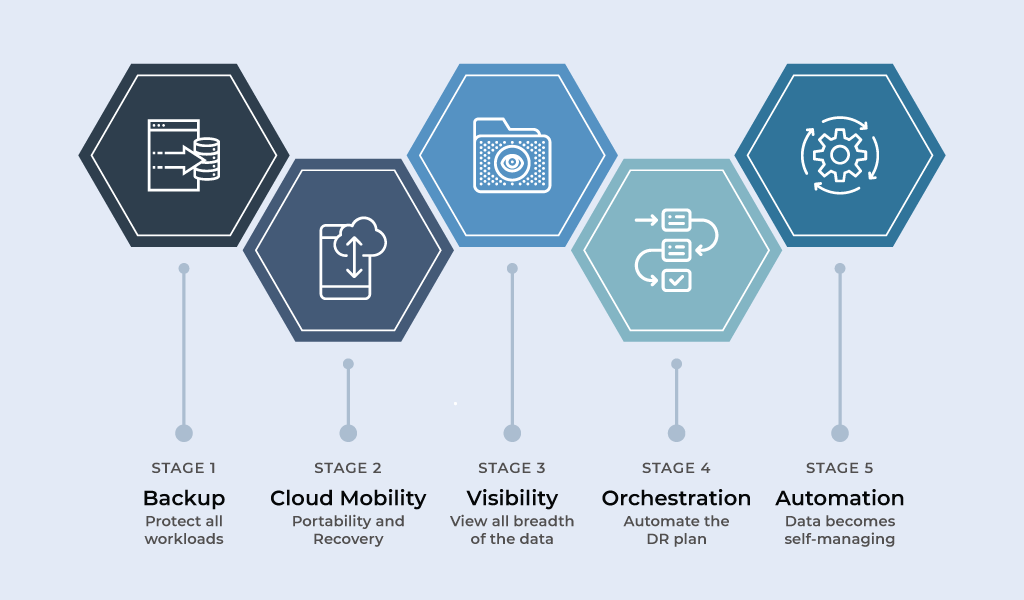
Veeam sees the majority of the market currently sitting at stage 1 or 2 providing a strong pipeline and growth path in taking customers along their ‘Act II’ journey.
Ecosystm Comment. We would raise some caution as the execution of this strategy may play out as more challenging than anticipated. Our research shows that a majority of companies – especially in emerging markets – see cloud as a means to shift the responsibility of data protection and availability, onto their cloud providers. The ongoing global Ecosystm Cybersecurity research reveals that nearly half the organisations rely solely on their public cloud provider to secure even their most sensitive data.
Figure 2: Perception on Public Cloud Security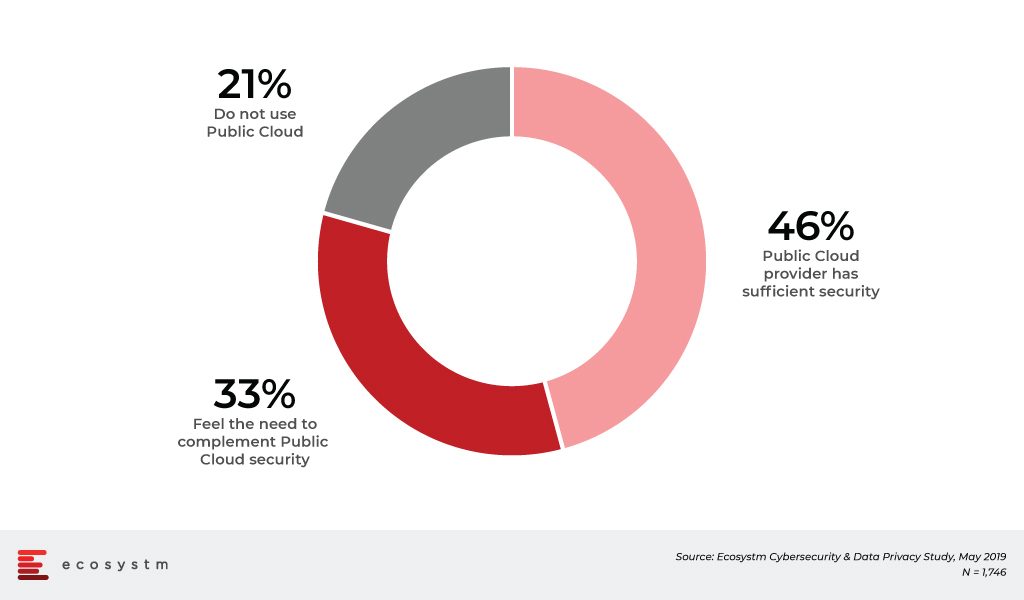
This finding is concerning when competitiveness has increasingly moved away from the traditional measures such as cost, quality and time to a company’s data and IP assets. So Veeam is urged to equip their partners and sales team with a strong educational message that the responsibility of data protection and availability cannot be shifted solely onto the cloud provider. The responsibility and accountability remains with the organisation and has to be managed across the increasingly hybrid environments.
Product Announcements
Keeping with the tradition, Veeam leveraged VeeamON 2019 as the platform for a number of product releases and announcements. In alignment with the business strategy, most of the new features support data management in hybrid cloud environments as well as new integrations and features for SaaS and Cloud platforms.
The most anticipated release of version 10 of Veeam’s flagship Availability Suite has not yet happened. Announced at VeeamON 2017, Version 10 will be released towards the second half of 2019. While the delay may be of concern, we would give Veeam credit for adopting a true SaaS model for their product development process. They have constantly released newer features and functionality to the current suite, opting to release some features faster to market to answer to specific customer demands at the time, such as centralised agent management support and Universal Storage API support. The key new features of Availability Suite 9.5 Update 4 include easy management of cloud migration and cloud mobility, cloud-native backup, cost-effective data retention, and portable cloud-ready licensing, increased security and data governance.
Veeam Availability Orchestrator v2 is the second generation of Veeam’s DR orchestration platform reducing the manual processes to achieve auditable DR, operational recovery and platform migrations. With increasing industry regulations this capability could give organisations of all sizes and resources the tools to prove and proactively remediate service level agreement (SLA) attainment for internal and external compliance regulations and audits with extensive reporting and compliance capabilities.
Nutanix Mine with Veeam is another product which received a lot of interest at VeeamON. With availability announced for late 2019, Mine is a partnership with Nutanix to provide more comprehensive and affordable solutions for secondary storage layers. Similar joint offerings have also been announced with ExaGrid. Mine provides Nutanix hyper-converged infrastructure with highly integrated Veeam Backup & Replication solutions to provide easy deployment and scaling, faster time to value and standardised IT operations management.
Ecosystm Comment. Ecosystm’s research shows that regulatory requirements are key to organisations’ propensity to invest in data protection and availability solutions. They are often built into the organisations’ risk management programmes as well.
Figure 3: Drivers of Continued Focus on Cybersecurity
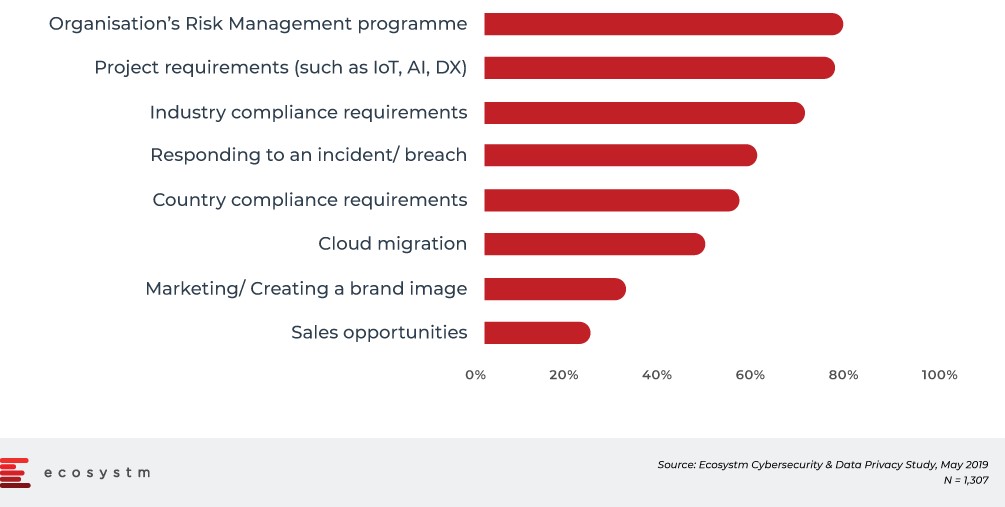
Availability Orchestrator v2 presents a strong entry point for Veeam to start the discussions for a more holistic data management solution. Providing the automation of the DR orchestration, scenario planning and auditable DR documentation strengthens Veeam’s claim to be the rightful owner of the Governance, Risk & Compliance (GRC) discussion. Furthermore, although it may be from leftfield, Ecosystm sees a great opportunity for some partnerships with Cybersecurity insurance companies to make Veeam Availability Orchestrator an accepted standard for Cybersecurity premium assessments and rebates. Ecosystm has seen a rapid rise of Cybersecurity insurance adoption with nearly 50% of global organisations already signed on to different policies. With adoption expected to accelerate over the coming years, Cybersecurity insurers could present a new route to market that is not in competition to its existing network of more than 60,000 partners.
Looking Ahead
Veeam has announced ‘Act II’ as the second stage of growth to carry on from their initial virtual machine-centred availability solution. The strategy follows the natural evolution and path of the market and will not require a major rethink or restructure of the Veeam business.
What is changing is the scale of business in geographical coverage, product portfolio and most importantly the Veeam partner ecosystem. In the same way that Veeam expanded their breadth in ‘Act I’ from the original VMware hypervisor backup to the broader hypervisor market and core infrastructure integrations, ‘Act II’ will require expansion across the key cloud platforms, exponentially growing SaaS landscape and the different tiered infrastructure providers.
Veeam’s product development teams have been one of the main beneficiaries of Veeam’s $500 million fund raising exercise earlier in 2019 (investors include Insight Venture Partners & Canada Pension Plan Investment Board) as they invested further in organic internal development instead of acquiring and integrating third party capabilities.
Geographical expansion is another area where the $500 million has been invested in. Veeam currently sits at 350,000 customers with 4,000 being added on a monthly basis. Emerging markets such as Asia Pacific are the engines of the growth but there are still markets and partnerships to be explored and developed. Across Asia Pacific alone Veeam opened 4 new offices in the first 5 months of 2019 and further expansions are planned for the months to come. The race for scale is essential to execute on ‘Act II’ but it brings operational challenges to scale in tandem with their operations while maintaining the culture that made Veeam what they are.
Ecosystm Comment. There is no doubt that there is a lot of work ahead of Veeam in executing on ‘Act II’. We have seen early proof that execution is following strategy, with new partnerships in the tiered storage space (such as Nutanix and ExaGrid), new products focussed across mainstream SaaS applications such as Office365 and tighter cloud integrations with Azure and AWS. There is currently lesser compatibility with Alibaba Cloud and no integration with Google which would be essential to accelerate their growth especially in Asia Pacific which has been highlighted as Veeam’s growth engine. The SaaS landscape presents an even tougher challenge for Veeam. Veeam Backup for Office365 has demonstrated the strong opportunity of workload-based availability solutions but developing the same capability across hundreds or thousands of diverse SaaS applications will present challenges. At the same time, we agree with Veeam’s focus on going deep into their solutions integration with the key partners and workloads that present the greatest opportunity today rather than spreading resources to put breadth over depths at this stage.
In 2013 Ratmir Timashev predicted to reach $1 billion within 6 years which was achieved just in time for VeeamON 2019. There were no new predictions made for ‘Act II’ but we see Veeam on the right path to announce tangible progress on their ‘Act II’ execution at VeeamON 2020 in Las Vegas.
I recently attended the Verint Engage event in Sydney, which had over 700 attendees. Conversations on artificial intelligence (AI) and analytics garnered a lot of attention this year. Verint showcased the deployments of intelligent conversational bots used by some of the biggest brands in Asia Pacific. Some of these customers include Spark NZ, Suncorp and AAMI. In 2018, the company acquired Next IT, a provider of conversational AI virtual assistant, to accelerate their move in the automation and analytics space. Verint’s choice of Next IT was driven by the need to provide their customers with a solution that has deep expertise in the contact centre space and to have an automation solution that is deeply integrated into their broad portfolio of solutions.
Last week, Verint announced the launch of AI Blueprint, a conversation analysis system that identifies intelligent virtual assistant (IVA) use cases and accelerates automation. The solution then delivers a “blueprint” of precisely how businesses can get started with AI or continue to grow their AI capabilities.
Verint is no stranger to the contact centre market and has an established presence in areas of quality monitoring, analytics, knowledge management and compliance.
Key Takeaways from Customers on Intelligent Virtual Assistants:
- Engaging senior stakeholders. For a successful deployment, many organisations had to involve senior management in the discussion. These ranged from CIOs, CDOs and CEOs. The conversation around automation and AI for customer service is no longer contained within the contact centre. Many organisations spoke about having senior management involved in the pre and post launch of the virtual assistant deployment. Getting buy-in and feedback from senior management is key as the AI discussion forms part of a broader digital strategy for the organisation. The global Ecosystm AI study, which is live and ongoing, also finds that senior management is the second highest influencer for AI procurement and implementations.
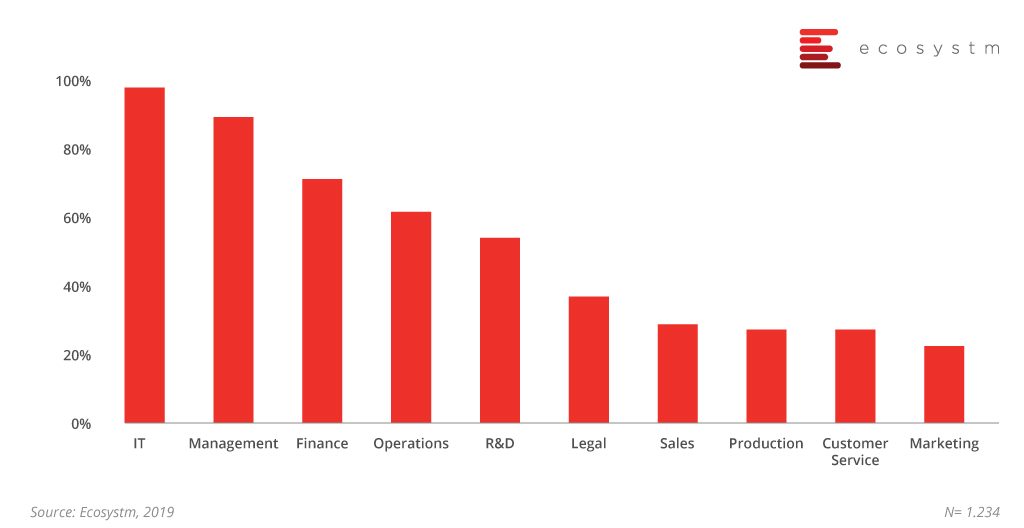
- Integrating Knowledge Management to the AI deployment is important. Organisations at the Verint Engage event highlighted that the route to a successful intelligent virtual assistant deployment is to embed knowledge management capabilities into the AI platform. By failing to incorporate knowledge management, the intelligent virtual assistant experience will be poor, leaving customers frustrated.
- Working with a vendor that understands contact centres is key. Some of the customers at the event had worked with other well-known brands AI in the market prior to working with Verint. They moved to Verint primarily for two reasons. One was that the cost of deployment was less on the Verint platform and secondly, they wanted to work with a vendor that not only understood AI but that had a deep understanding of the contact centre environment. Compliance, training, speech analytics, coaching and quality monitoring are core capabilities of Verint’s portfolio. These are important elements in the overall deployment of AI.
- Striking the right balance between automation and voice. Several of the organisations highlighted the savings realised, when the deployment was done well and fully integrated into knowledge management. Automation will in the long run help reduce contact centre calls and live chat costs. However, it was emphasised that the agent or human element remains important and cannot be ignored. The seamless hand off to the agent when the query cannot be answered is important.
Ecosystm Comment:
Virtual assistants need to be fed with the right information to make the discussion with the customer engaging. A solid knowledge management strategy is key to the success of a virtual assistant deployment. Without analytics and knowledge management integrated into AI, the CX will be poor leaving customers feeling frustrated. When deployed well, the virtual assistant can help answer most of the queries due to a structured knowledge bank with detailed FAQ. The ability to have it updated regularly and in real time is critical. It is important for contact centres to not rely on full automation within the contact centre.
Verint is starting to win deals in the AI and virtual assistant space with some of the largest brands in Asia Pacific. Some of the customers include those from the financial services sector. Verint’s success is not just in the intelligent virtual assistant market. It is their ability to deliver an all-encompassing solution across self-service, analytics, knowledge management, quality monitoring and compliance.
Authored by attending Ecosystm Advisors and Analysts: Randeep Sudan, Amit Gupta, Tim Sheedy, Lokesh Tayal and Sash Mukherjee
IBM has been sending strong messages about their future business goals in Asia Pacific, to the analyst community and the larger market as a whole. Over the last 2 analyst briefings held in Melbourne (August 2018) and Singapore (November 2018), they have emphasised their focus on the ‘Hero Brands’, the multicloud, their Open-First policy, and their One IBM messaging.
Based on our analysis, it is clear that IBM is:
Consolidating their Portfolio into ‘Hero Brands’. IBM’s portfolio has been consolidated into IBM Services, IBM Watson, IBM Cloud, IBM Security, IBM Systems and IBM Research. This consolidation represents a holistic and cross-cutting approach to the market and is likely to give IBM an edge in implementing emerging technology solutions. As an example, the Technology Support Services (under IBM Services), leverages both Watson-enabled support and Blockchain-based billing and invoicing.
Ecosystm Comment. IBM Watson still remains a flagship brand for the organisation and should be integrated more within the stories of the other ‘Hero Brands’. While the penetration of Watson capabilities has grown, it is not what it should be, considering that IBM has first-mover advantage in the cognitive/AI market. IBM needs to actively play to their strengths and build further capabilities leveraging the Watson/ IoT/ Blockchain ecosystems.
Focusing on the Multicloud. IBM’s strong experience in cloud deployment, migration and management gives them a true understanding of the cloud adoption landscape. They are pushing the concept of the multicloud, leveraging their capabilities to manage other vendors’ clouds, acknowledging the reality that organisations are at disparate stages when it comes to cloud adoption, and that they all have their own unique journeys. While the public cloud with cloud native workloads, is the end-game, IBM understands that their clients run their workloads across public, private and hybrid clouds, and have developed a capability to support all of these environments.
Ecosystm Comment. For many of IBM’s traditional clients, this is the right approach to take – these are companies with typically highly complex environments where simple messages around “take it all to the public cloud” might be more easily said than done. IBM will work with these clients to help them modernise their business and make the most of their current on-premise and hosted applications. Moreover, data localisation requirements in some countries will also require a hybrid approach to the management of cloud assets. While the market implications of IBM’s Red Hat acquisition are being discussed at length, other initiatives such as strengthening their automation capabilities, extending their relationship with ServiceNow, and their Open-First policy will also benefit IBM and the market as a whole.
Creating a Services Differentiation. The Managed Applications division under Global Technology Services (GTS) – that works closely with Global Business Services (GBS) acknowledges that managing SAP and Oracle applications on IBM Cloud is their fastest growing market. So, given the plethora of service providers, especially in the region, how do they create a differentiation? IBM’s response is to infuse ERP deployments with change management capabilities to help companies become truly digital. This is bolstered by their Industry Impact Solutions, and the One IBM messaging. GTS and GBS coming together to deliver an end-to-end solution, can potentially give their clients a better understanding of the technological requirements, change management, and TCO.
Ecosystm Comment. In the studies conducted by Ecosystm, IBM features as the vendor with the highest mindshare for IoT and Mobility and comes in at 2nd spot for AI. However, where they clearly lead the market is in being the services provider of choice when it comes to Digital Transformation (DX).
Top of Mind Services Providers for DX, Asia Pacific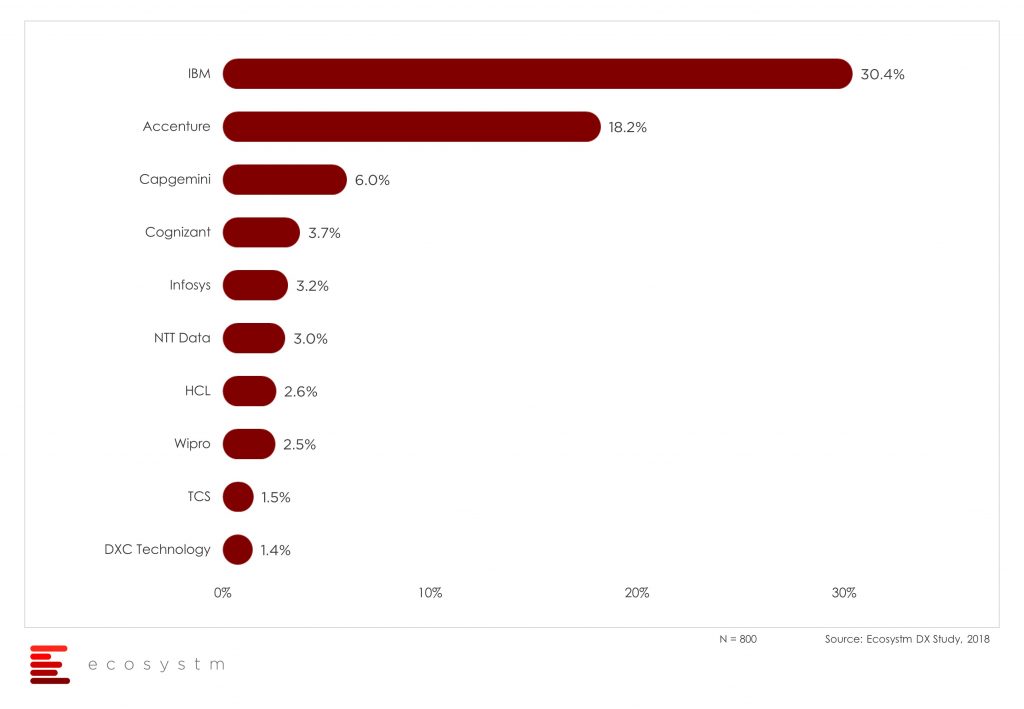
As organisations make the transition to digital operating models, services providers that can provide scale and skill, will become significant partners in the journey. IBM indisputably has both scale and skill, and the One IBM messaging can further strengthen their market position as the service provider of choice for DX. However, this messaging should be far more consistent and run across IBM’s entire operations for better market positioning.
Improving their Customer Capabilities. Over the past few years IBM has invested in its delivery capabilities, with design thinking, ideation sessions and customer journey mapping, included in many of their client engagements. They have brought in experts from outside of IBM to provide many of these capabilities – uncharacteristically, many of the IBMers you meet who offer or drive these services are new to the organisation. They are also driving new technology processes and capabilities within many of their clients – moving beyond simple systems integration to helping their clients change their internal digital delivery processes.
Ecosystm Comment. In an era where change is constant, the ability to drive change within the business will be central to the ability to succeed in the market. Too many companies bring in external consultants and SIs and instead of leading the change, they let the SI lead the change. They do not take many – or any – learnings out of the engagement and are completely reliant on external consultants every time they need a big change. While this is a great opportunity for the SI and consultancy providers, many companies – IBM included – want their clients to succeed. So instead of selling them lemonade, more and more they are teaching them to make their own lemonade.
Recently I attended Ericsson’s Industry Analyst Day in Boston where Ericsson’s leaders updated the analyst community on the state of the company both globally and in North America. They also deep dived into the network evolution to 5G, AI, Automated Operations,5G and IoT Industry Innovation. With my focus on IoT, I was keen to hear what was new in IoT platforms, cellular connectivity, secure IoT 5G services, and Industry 4.0 use cases.
Corporate Update:
As part of the very public turnaround plan, Helena Norrman, Ericsson’s SVP and Chief Marketing and Communications Officer and Head of Marketing and Corporate Relations announced the following: Ericsson’s focused strategy continue to be based on a vision to empower an intelligent, sustainable connected world while enabling the full value of connectivity for service providers. Results of the strategy included accelerated cost cut – which was on plan to reduce expenses by 10 Billion Swedish Kroners (SEK), with an improved cash position by over 11 Billion SEK.
While not out of the woods yet, it appeared that the renewed focus on business efficiency, improved end-customer experience and new revenue streams has given Ericsson a level of optimism that hasn’t been seen for at least 4 years. For example, Norrman shared that Ericsson’s networks had become 50% more efficient in energy consumption on footprint and operations optimization. She indicated that new digital services were being rolled out 86% faster than before. Finally, she indicated that Ericsson had achieved 201% RoI in the first year for an IoT-based factory maintenance system.
In his update, Niklas Heuveldop, President and Head of Ericsson North America, suggested that there might be continued changes for the big 4 US-based telecom operators. With a background of a six-fold increase in mobile data, mobile revenue remains flat, blended ARPUs declining, and cellular connections (including IoT) growing by 4.4% from 398 million 3Q-2016 to 434 million 2Q-2018, he indicated that operators would have to look for new revenue streams to stay profitable. This was on top of a new operator market that may change structurally as a result of the T-Mobile/Sprint merger (offering a broad range of spectrum for both consumer and enterprise customers), and the arrival of new wireless network operators.
5G and IoT
The day was dominated with the business opportunities based off 5G networks, as Ericsson continues to look to expand the addressable markets by enabling new revenue streams. For example the combined Critical and Massive IoT markets based off 5G networks could range between $200 – $600 Billion as part of scale driven and performance driven opportunities in markets such as Industry 4.0.
However, this is a new looking Ericsson who shared its new IoT strategy. Jeff Travers, head of IoT, was clear that IoT would follow a path of disciplined growth with goals to:
- Capture new revenues through rapid innovation building on 5G and IoT
- Make our primary customers, services providers, succeed in new value pools
- Use a lean startup approach to validate and scale ideas.
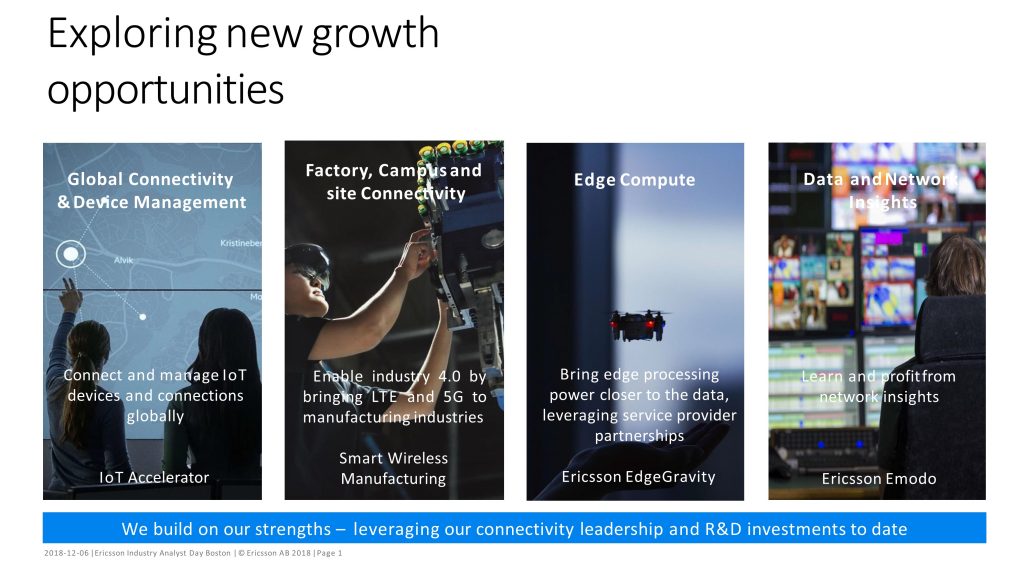
These goals would be achieved off the backs of things that Ericsson does well:
- Build a connectivity platform:- IoT Accelerator
- Be the forefront partner in Industry 4.0 wireless connectivity
- Aggressively position itself as a leading partner in Edge Computing for its operator customers and network partners: – Ericsson EdgeGravity
- Processing and providing network insights and analytics :- Ericsson Emodo
Analyst Opinion:
5G and IoT have been pushed by the major operators for some time and the industry has been holding its breath as vendor after vendor attempts to craft a profitable business strategy and identify use cases that deliver an acceptable RoI. Most have not yet either reached scale because of the lack of readiness of the whole ICT infrastructure once IoT devices are connected. Too much emphasis has been placed on too few IoT applications at the edge of the network. Too much hope has been placed on Edge Computing without meeting customers’ needs of an end-to-end solution.
However, we belief that Ericsson’s clear focus on connecting IoT devices, while maximizing the edge computing needs through local analytics while enabling operators to partners with cloud service providers will open up vertical industries such as manufacturing to IoT deployments. Ericsson’s solution for wireless capabilities within Industry 4.0 could be readily accepted by customers who want to transform themselves to digital-based businesses.
HPE’s announcement in Madrid regarding its build out of Edge Computing services and solutions is to be expected as more of its customers and prospects look to establish comprehensive data and systems management functions at the edge of the IT network. As more data is created outside of the traditional data centre walls, IT needs to be able to provide the same level of integrity for the remote locations. HPE’s announcement of the Edgeline systems management fills that gap. However, this does signal to CIOs and lines of businesses that they will now have to continue this build out of full remote distributed IT services to include data backup, recovery, application device management, etc :- expect HPE to continue to make future announcements to meet those needs. Industrial partners such as industrial players like PTC will benefit from this announcement as it will enable their products to run in a more enterprise-class environment.
HPE’s announcement to provide an open link platform between industrial and IT connectivity protocols is again a reflection of a maturing IoT market. As businesses move from proof of concept into production, more varied input sources from differing factory floor devices could or should be connected. The open link platform is a way to encourage and speed up that connectivity.
However, our IoT study data indicates that enterprises who are adopting large scale IOT projects prefer to work with software and analytics vendors, rather than pure-play hardware vendors. Today’s announcement is a way for HPE to demonstrate to its customers and prospects that it is more than an ‘edge server’ hardware company, but that it can provide full systems management services. Its biggest competitor in this field, DELL EMC will argue that it too can provide these services across its company portfolio.
Figure: Primary Partners for Current IoT Projects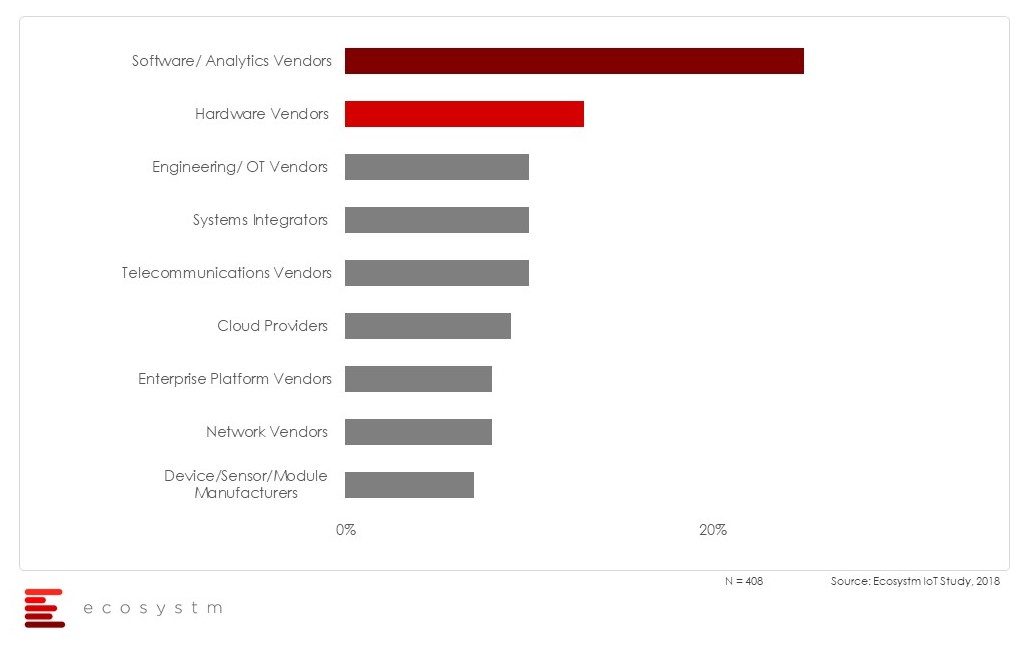
Finally: our advice to tech buyers is that those who want to build out an edge infrastructure will need to plan to support a fully integrated data and systems management environment and therefore look to a vendor who can replicate their enterprise solutions and support capabilities. This may be in contrast to their distributed cloud computing strategy which HPE have not articulated but will need to over time.


